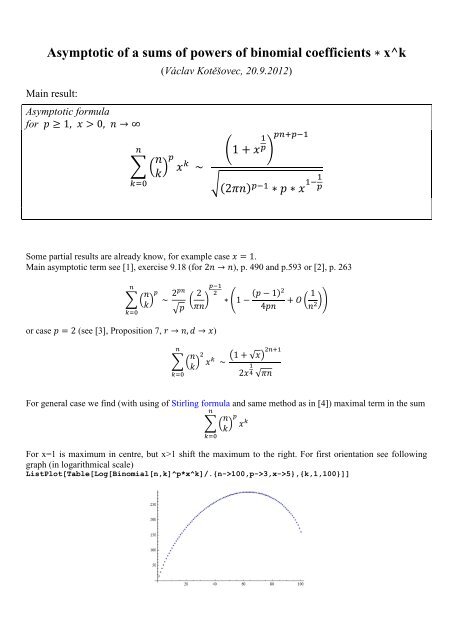Asymptotic of a sums of powers of binomial coefficients x^k
Asymptotic of a sums of powers of binomial coefficients x^k Asymptotic of a sums of powers of binomial coefficients x^k
Asymptotic of a sums of powers of binomial coefficients(Václav Kotěšovec, 20.9.2012)x^kMain result:Asymptotic formulaforSome partial results are already know, for example case .Main asymptotic term see [1], exercise 9.18 (for ), p. 490 and p.593 or [2], p. 263or case (see [3], Proposition 7, )For general case we find (with using of Stirling formula and same method as in [4]) maximal term in the sumFor x=1 is maximum in centre, but x>1 shift the maximum to the right. For first orientation see followinggraph (in logarithmical scale)ListPlot[Table[Log[Binomial[n,k]^p*x^k]/.{n->100,p->3,x->5},{k,1,100}]]
- Page 2 and 3: In normal scale is the situation fo
- Page 4 and 5: First part is interesting. Here are
- Page 6: Recurrencesx=1 general xp=2 A000984
<strong>Asymptotic</strong> <strong>of</strong> a <strong>sums</strong> <strong>of</strong> <strong>powers</strong> <strong>of</strong> <strong>binomial</strong> <strong>coefficients</strong>(Václav Kotěšovec, 20.9.2012)<strong>x^k</strong>Main result:<strong>Asymptotic</strong> formulaforSome partial results are already know, for example case .Main asymptotic term see [1], exercise 9.18 (for ), p. 490 and p.593 or [2], p. 263or case (see [3], Proposition 7, )For general case we find (with using <strong>of</strong> Stirling formula and same method as in [4]) maximal term in the sumFor x=1 is maximum in centre, but x>1 shift the maximum to the right. For first orientation see followinggraph (in logarithmical scale)ListPlot[Table[Log[Binomial[n,k]^p*<strong>x^k</strong>]/.{n->100,p->3,x->5},{k,1,100}]]
In normal scale is the situation following:For finding <strong>of</strong> the maximum we must solve a equationWith help <strong>of</strong> program Mathematica:stirling[n_]:=n^n/E^n*Sqrt[2*Pi*n];binom[n_,k_]:=stirling[n]/stirling[k]/stirling[n-k];Simplify[D[Simplify[binom[n,k]^p*<strong>x^k</strong>],k]]Simplify[(-2k*p+n*p+2k(-k+n)p*Log[k]+2k(k-n)p*Log[-k+n]+2k^2*Log[x]-2k*n*Log[x])/.k->(q*n)]Now we reduce terms which tends to zero ifLimit[(p-2p*q-2n*p(-1+q)q*Log[n*q]+2n*p(-1+q)q*Log[n-n*q]-2n*q*Log[x]+2n*q^2*Log[x])/n,n->Infinity]Solve[p*Log[1-q]-p*Log[q]+Log[x]==0,q]Maximum is inFor example, in previous case, we have maximum in2
Good estimate (lower bound) is now value in maximum:but right asymptotic has little bigger value. We will now analyze neighbourhood <strong>of</strong> maximum, .From logarithmic form <strong>of</strong> the Stirling formula we obtain (with help <strong>of</strong> Mathematica)lognfak[n_]:=n*Log[n]-n+1/2*Log[n]+1/2*Log[2*Pi];t=x^(1/p)*n/(1+x^(1/p));FullSimplify[p*(lognfak[n]-lognfak[t+k]-lognfak[n-t-k])+(t+k)*Log[x]]We now apply the first two terms from Taylor series (near 0)and approximateslog[k_,n_]:=Log[n]+k/n-1/2*(k/n)^2;Result has two parts, each we must return back to exponential form.Second part is equal to value in maximum:3
First part is interesting. Here are 3 cases. If we compare, thenif limit Exp(limit)0 1>10Green lines are and , where t is maximum and c is some constant.Therefore only case has some asymptotic weight (only between green lines are dominant terms).Values out <strong>of</strong> these bounds tends (in comparing with value in the maximum) asymptotically to zero.Now we compute contributions <strong>of</strong> other terms (near maximum) yetBy merging <strong>of</strong> the both parts we obtainBut(for pro<strong>of</strong> see [1], pp.482-485). Here isand4
More detailed asymptotic is thenFor x=1 this result according toNumerical verification, example forShow[ListPlot[Table[(Sum[Binomial[n,k]^p*<strong>x^k</strong>,{k,0,n}])/((1+x^(1/p))^(p*n+p-1)/Sqrt[(2*Pi*n)^(p-1)*p*x^(1-1/p)]*(1-(p-1)*(2p-1)/(6*p*n)+(p-1)*(p+1)*(x^(1/p)+1/x^(1/p))/(24*p*n)))/.{p->3,x->4},{n,1,100}]],Plot[1,{n,1,100},PlotStyle->Red],PlotRange->{0.999,1.001},AxesOrigin->{0,0.999}]Sequences in OEISx=1 x=2 x=3 x=4 x=5 x=6p=1 A000079 (<strong>binomial</strong> theorem)p=2 A000984 A001850 A069835 A084771 A084772 A098659p=3 A000172 A206178 A206180 A216483 A216636 A216698p=4 A005260 A216696 A216795p=5 A005261p=6 A069865p=7 A182421p=8 A182422p=9 A182446p=10 A1824475
Recurrencesx=1 general xp=2 A000984 H. A. Verrill, 1.2.2008 [9]p=3 J. Franel, 1894 [6], A000172 V. Kotěšovec, 15.9.2012 [5]p=4 J. Franel, 1895 [6], A005260 V. Kotěšovec, 16.9.2012 [5]p=5 M. A. Perlstadt 1987 [7], [8], A005261p=6 M. A. Perlstadt 1987 [7], [8], A069865p=7 V. Kotěšovec, 28.4.2012 [5], A182421p=8 V. Kotěšovec, 28.4.2012 [5], A182422p=9 V. Kotěšovec, 29.4.2012 [5], A182446p=10 V. Kotěšovec, 29.4.2012 [5], A182447General recurrences-(x-1)^4*(n+1)^3*(n+2)*(16*(4*x^2 + 17*x + 4)*n^4 + 184*(4*x^2 + 17*x + 4)*n^3 + (3137*x^2 + 13351*x + 3137)*n^2 + (5867*x^2 + 25051*x + 5867)*n +4061*x^2 + 17438*x + 4061)*a(n)+ (n+2)*(64*(4*x^5 + 141*x^4 + 655*x^3 + 655*x^2 + 141*x + 4)*n^7 + 1024*(4*x^5 + 141*x^4 + 655*x^3 + 655*x^2 + 141*x + 4)*n^6 + 4*(6857*x^5 +242368*x^4 + 1126775*x^3 + 1126775*x^2 + 242368*x + 6857)*n^5 + 8*(12439*x^5 + 442336*x^4 + 2059985*x^3 + 2059985*x^2 + 442336*x + 12439)*n^4+ (211031*x^5 + 7579744*x^4 + 35400065*x^3 + 35400065*x^2 + 7579744*x + 211031)*n^3 + (261344*x^5 + 9524206*x^4 + 44667470*x^3 + 44667470*x^2+ 9524206*x + 261344)*n^2 + (174888*x^5 + 6498997*x^4 + 30655175*x^3 + 30655175*x^2 + 6498997*x + 174888)*n + 15*(3251*x^5 + 123835*x^4 +588594*x^3 + 588594*x^2 + 123835*x + 3251))*a(n+1)-(32*(12*x^4-197*x^3-1030*x^2-197*x + 12)*n^8 + 624*(12*x^4-197*x^3-1030*x^2-197*x + 12)*n^7 + 10*(6295*x^4-103673*x^3-542004*x^2-103673*x +6295)*n^6 + 4*(74418*x^4-1233343*x^3-6448430*x^2-1233343*x + 74418)*n^5 + (864893*x^4-14467663*x^3-75685660*x^2-14467663*x + 864893)*n^4 +20*(78938*x^4-1336491*x^3-7002327*x^2-1336491*x + 78938)*n^3 + (1764932*x^4-30321697*x^3-159367410*x^2-30321697*x + 1764932)*n^2 +(1102551*x^4-19262286*x^3-101826010*x^2-19262286*x + 1102551)*n + 10*(29405*x^4-523232*x^3-2793306*x^2-523232*x + 29405))*a(n+2)+ (n+3)*(64*(4*x^3 + 21*x^2 + 21*x + 4)*n^7 + 1152*(4*x^3 + 21*x^2 + 21*x + 4)*n^6 + 12*(2899*x^3 + 15226*x^2 + 15226*x + 2899)*n^5 + 4*(35609*x^3+ 187226*x^2 + 187226*x + 35609)*n^4 + (340693*x^3 + 1795162*x^2 + 1795162*x + 340693)*n^3 + (474743*x^3 + 2511132*x^2 + 2511132*x +474743)*n^2 + (355831*x^3 + 1894439*x^2 + 1894439*x + 355831)*n + 10*(11039*x^3 + 59401*x^2 + 59401*x + 11039))*a(n+3)-(n+3)*(n+4)^3*(16*(4*x^2 + 17*x + 4)*n^4 + 120*(4*x^2 + 17*x + 4)*n^3 + (1313*x^2 + 5599*x + 1313)*n^2 + 15*(103*x^2 + 443*x + 103)*n + 659*x^2 +2882*x + 659)*a(n+4) = 0Recurrence order is .Conjecture (V. Kotěšovec, 19.9.2012): foris maximal degree <strong>of</strong> polynomials in n(=A131941( ), holds for )References:[1] Graham R. L., Knuth D. E. and Patashnik O., Concrete Mathematics: A Foundation for Computer Science, 2nd edition, 1994.[2] Kotěšovec V., Non-attacking chess pieces, 5th edition, 9.1.2012[3] Noble R., <strong>Asymptotic</strong>s <strong>of</strong> a family <strong>of</strong> <strong>binomial</strong> <strong>sums</strong>, J. Number Theory 130 (2010), no. 11, 2561-2585[4] Kotěšovec V., <strong>Asymptotic</strong> formula for number <strong>of</strong> fat trees on n labeled vertices, website 25.8.2012[5] OEIS - The On-Line Encyclopedia <strong>of</strong> Integer Sequences[6] Franel J., Intermediaire des Mathematiciens, 1894, p.45-47, 1895, p.33-35[7] Perlstadt M. A., Some Recurrences for Sums <strong>of</strong> Powers <strong>of</strong> Binomial Coefficients, Journal <strong>of</strong> Number Theory 27 (1987), pp.304-309[8] Elsner C., On recurrence formulae for <strong>sums</strong> involving <strong>binomial</strong> <strong>coefficients</strong>, 2002-2003[9] Verrill H. A., Sums <strong>of</strong> squares <strong>of</strong> <strong>binomial</strong> <strong>coefficients</strong>, with applications to Picard-Fuchs equations, 1.2.2008This article was published on website http://web.telecom.cz/vaclav.kotesovec/math.htm, 20.9.20126



